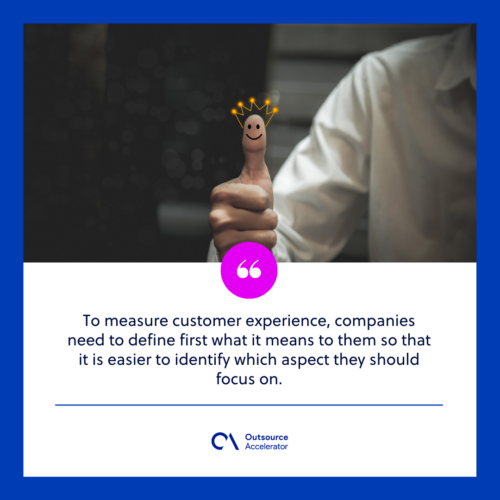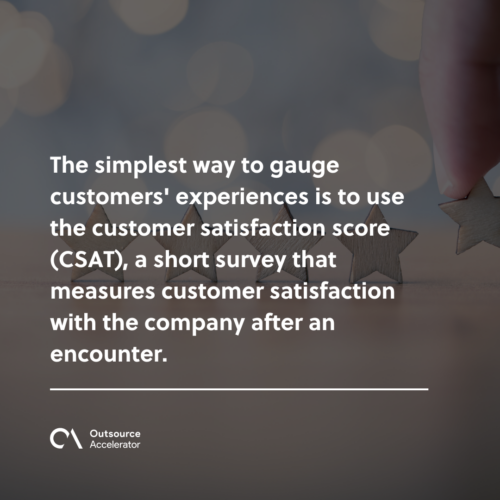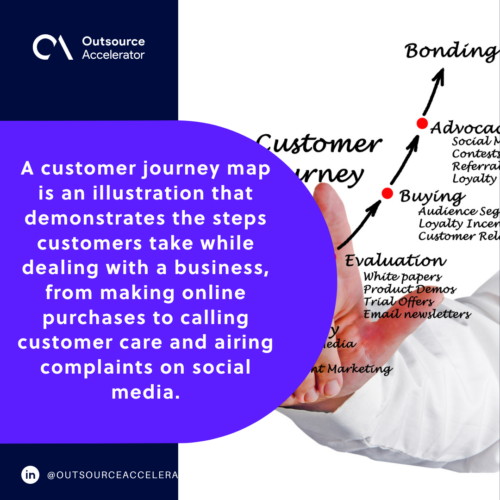Metrics to effectively measure customer experience

Customer experience is simply the impression a business leaves them. It determines how they think of a company as a brand. If they are left with a good impression, they will most likely become loyal customers.
If a business wants to increase client retention, measuring customer experience using specific metrics should occur.
What are the components of customer experience?
Before a company can measure customer experience, it needs to first identify the components of customer experience. This way, it is easier to focus on specified aspects and achieve the desired numbers.
Here are the four components of customer experience:
Customer-centric culture
A customer-centric culture is where the customer is at the center of how the entire business thinks and behaves. Rather than just a department, customer service should encompass all the aspects of the company.
The level of interactions in the company’s internal operations is directly correlated with external customer experience. If companies think of and treat their workers as internal customers, these workers would definitely apply the same level of engagement to external clients.
Employees come before customers, not the other way around. They will look out for the customers if the company looks out for them.
Service experience design
Service experience design refers to the method by which the company plans, develops, and concentrates on producing the best possible customer experiences.
This involves taking a comprehensive picture of the entire organization and investigating every client interaction to make sure that they are cohesive, memorable, and produce a real market-leading distinction.
Unfortunately, many companies do the exact opposite. Without giving proper thinking or consideration, input, or testing with actual customers, they construct technical solutions, products, and services from the ground up.
Companies need to specify how they intend to deal with customers. They need to determine what the ultimate customer service experience is and use it as a guide on how to provide that experience. They should determine what their customers want, need, and care about.
Service experience delivery
Any consumer understands that they are unlikely to receive a quick response to a hard inquiry. Even if this is the case, they still anticipate receiving one in a timely manner.
The first step is to establish precise response times for client inquiries. From here, businesses can expand into more comprehensive service level agreements or a customer charter that establishes the criteria for how they want their customers to be treated.
Customer satisfaction
A customer satisfaction survey is a crucial component of every flourishing enterprise. A crucial element of this is asking for their opinions.
Companies will gain a wealth of insight if they can evaluate it from the outside in. This greatly helps in continuous improvement, which is the one thing that will always benefit any business.

Types of metrics to measure customer experience
There are tons of different metrics used to measure customer experience, though most of them can be categorized into five:
CSAT (Customer satisfaction)
One of the simplest ways to gauge customers’ experiences is to use the customer satisfaction score (CSAT). This short survey measures customer satisfaction with the company after an encounter.
CSAT can help companies get a sense of the customer experience even though it is normally employed as a customer service metric. This is because support interactions are a significant part of the customer experience.
For instance, a consumer can rate a support agent’s response depending on how satisfying or useful the solutions are after speaking with a live person via online chat.
Companies can also ask about a customer’s satisfaction with a good or service after they have purchased it.
Customer churn, loyalty, and retention
The churn rate is the number of subscribers or customers who discontinue their subscriptions or do not renew them within a specific time frame.
Even while customer churn is unavoidable, it’s still critical to understand why it occurs so steps can be taken to minimize it.
The opposite of the churn rate is the customer loyalty or retention rate. This aids in determining customer loyalty by counting the number of consumers a company keeps over a predetermined period of time.
These metrics can be retroactive, like average tenure, or more indicative of a customer’s tendency to stay a customer. It includes frequency of purchase, the use of a number of channels, participation in loyalty programs, repeat orders, return rates, and average order size.
Brand, reputation, and advocacy
In brand advocacy, word-of-mouth marketing is used to promote the business. Customers who frequently share their favorable opinions and experiences with the brand on social media can help showcase it to new clients and have a positive impact on sales.
About half of the purchases are influenced by brand enthusiasts. This could be done through social media or word-of-mouth, as majority of buyers claim that a suggestion from a friend or family member also affects their decision to buy.
Operations and Quality
Customers want to make sure that they have the same experience each time they interact with the customer service team. In addition to receiving excellent customer service, they also want to make sure that protocols are in place to protect their sensitive information.
Companies need to make sure that each of their team members is adhering to the same guarantee—providing excellent service and ensuring that all compliance rules are observed.
Unfortunately, this set of metrics is underrated. Companies need to keep in mind, however, that no matter what steps are made to fix the issue, when a good or service doesn’t match expectations, the customer experience suffers.
Employee engagement
Employee engagement is the final indicator that is deemed significant. Engaged staff members are said to give better service and contribute to higher levels of customer satisfaction.
Companies need to ensure that workers are treated fairly and have a channel to speak up about their concerns. If employees are invested in the company, it will be easier to keep them on board, which improves consistency and quality.

How to measure customer experience
Measuring customer service experience is crucial. The numbers can determine how simple or complex a brand’s products are to use. This directly affects whether or not the customers recommend it to their friends and colleagues or continue doing business with the brand.
To do this, companies must collect customer feedback.
Surveys
One method of gauging customer experience is through surveys. Surveys can be sent after a consumer makes a purchase or contacts the customer service line.
Client surveys can be conducted to get opinions on a new good or service. It also provides insights into the company’s strengths and potential improvement areas.
Surveys that collect customer feedback come in many forms, like
Long form-based surveys. The most popular method of closing the feedback loop is through customer feedback questionnaires. Typically, it entails emailing a list of questions.
Short in-app surveys. When a user has done interacting with a certain app feature, they may be prompted to complete the survey. Given that the user is currently using the feature, their feedback will likely be clear, concise, and straightforward.
Exit-intent survey pop-up. This is a great way to gather client feedback. Although they can all be employed in different ways, they are all activated when a visitor is about to leave your website.
Customer journey maps
A customer journey map is an illustration that demonstrates the steps customers take while dealing with a business, from making online purchases to calling customer care and airing complaints on social media.
A client’s entire engagement with a company is referred to as their “customer journey.” It includes all customer interactions across every stage of the customer lifecycle, from awareness to loyalty, across all channels, platforms, and interfaces.
The customer journey is not something that is based on prediction or the company’s internal viewpoint. It is highly distinctive to the customers’ physical experiences. This is why companies need to ask customers about it and create a customer journey map.
A customer journey map may include the following.
Buying process. This part includes an outline of the steps the customer will take to accomplish the task that the brand wants them to do.
User actions. This section examines the numerous methods the consumers might use to accomplish the objective. It essentially contains all the actions that the customer has done during the buying process.
Emotions. Keep in mind that customers are trying to solve an issue. This implies that they are presumably experiencing some sort of emotion, be it relief, joy, excitement, or worry.
Customers may experience a range of emotions throughout the course of the process if it is lengthy or complex. By including this on the journey map, companies may reduce bad feelings about the journey and don’t turn into negative opinions about the brand.
Pain points. Every unpleasant emotion has a pain point that led to it. Brands may determine which stage the consumer is feeling negative emotions and determine why by adding pain points to their customer journey map.
Solutions. This is the part where the company evaluates potential methods to enhance its buying process. This way, customers have fewer pain points and are happier while doing business with it.

A consolidated view in measuring customer experience
The success of both customers and businesses depends on effective customer experience measurement. However, most businesses find it to be a significant challenge.
Companies that seek to measure customer experience must first establish what customer experience means to them. If they do this, they’ll find that it is much easier to determine the metrics that they need to use.
Excellent customer experience comes from within. It has to be all-encompassing and not just confined to one department. If the entire company’s culture is customer-centric, all aspects of the business will follow through.







 Independent
Independent




